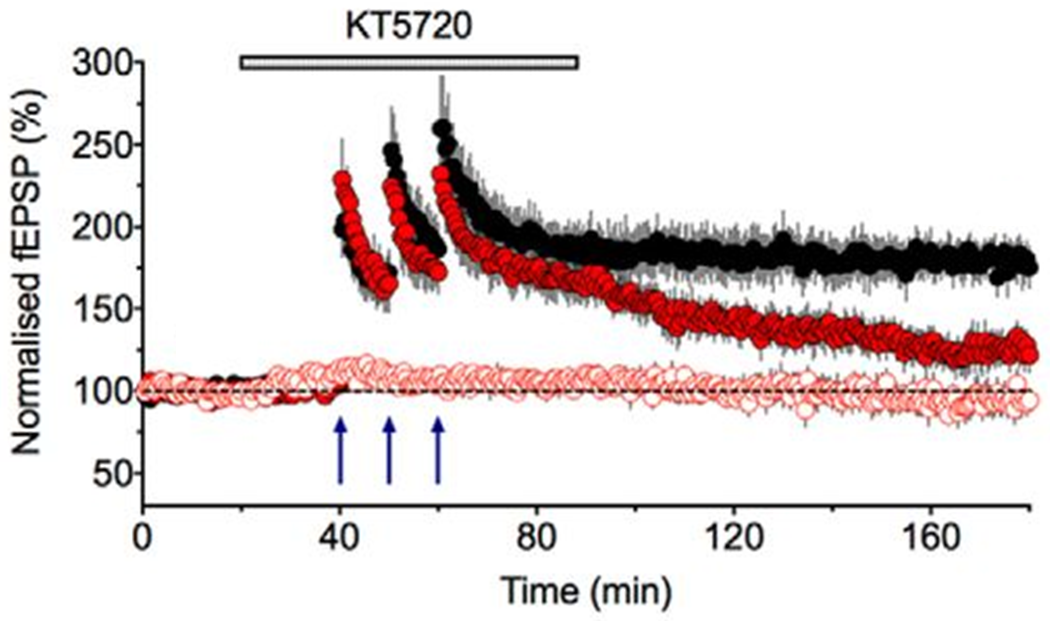- View sweeps by clicking on an Analysis
Graph data point - Impose single and averaged sweeps
- Quarantine bad sweeps in reanalysis
- PopSpike Area, Amplitude & Latency
- Three types of Slope measurement
- Analyze all EPSPs in a sweep
- Special analyses of trains Rs measurement from unfiltered trace
- Convert WinLTP data files to ABF files
- Reanalysis of ABF, IBW and WCP files
| Protocol Builder |
The Protocol Builder and Multitasking are at the heart of WinLPT. The Protocol Builder enables complicated protocols to be built using ‘building blocks’ pulled down from the green User Interface buttons. These building blocks include Loops, Delays, Runs and Sweeps (with various stimulations). WinLTP protocol flow of execution can be easily changed during runtime by checking or unchecking the Loop, Delay, Run and Sweep checkboxes. Sweep and Delay Periods can also be changed during runtime, as can all sweep stimulation values. Protocol Builder scripts can either be circular or sequential.
To our knowledge, the only electrophysiological data acquisition program to have a protocol editor similar to WinLTP's is Heka's Patchmaster.
Circular Scripting
In circular scripting, usually a Run Once event is placed inside the Continuous Loop, and this Run Once event usually contains complex induction stimulations as shown in Fig. 1.1 and 1.2. See Chapter 7 in the online manual for more information.
For more information see Chapter 7 in the on-line WinLTP Manual.
|
|
| Fig. 1.1. This figure shows one of the simplest useful LTP circular script protocols that cannot be made with the Basic Version, but requires the Protocol Builder: minimal grouped stimulation with periods of rest, rather than continuous stimulation. This is created by dragging down a Delay statement. Delay was changed from 180 to 60 sec. at the arrow. (In the Protocol Builder figures, channel AD0 records S0 output, AD1 records S1 |
 |
|
|
| Fig. 1.2. The top figure shows Slow Repeat Train Stimulation with single pulse sweeps between the trains to induce LTP (Park et. al., J. Neuroscience, 36:622–631). The bottom figure shows a protocol to generate slow repeat train stimulation, where clicking the Run check box (arrow) evokes 4 trains of stimulation separated by single pulse sweeps. A similar stimulation protocol is also used in In-Vitro Kindling (Stasheff et al., Science, 245:648-651, 1989) |
|
|
| Fig. 1.3. A more complex protocol showing LTP train stimulation in the S0 pathway immediately followed by LTD stimulation in the S1 pathway but with continuing slow S0 stimulation. Stimulation was started by clicking the Run check box (arrow). |
Sequential Scripting
In contrast to circular scripting, sequential scripts follow a linear, not circular, order of events, and this is what experiments really are - a linear sequence of events. Sequential scripts usually start out with a Baseline Loop so that a stable baseline can be established before the rest of the experiment is run. Then this Baseline Loop is unchecked (see red arrow in Fig. 1.4), and the rest of the experiment stimulation runs without requiring any researcher input. See Chapter 8 in the online manual for more information.
For more information see Chapter 8 in the on-line WinLTP Manual.
|
|
| A sequential script where, after a steady baseline has been determined, the entire stimulation sequence is started by unchecking the Continuous Loop checkbox (red arrow). The rest of the protocol runs without the researcher having to be present. |
Sequential Scripting with Automated Perfusion Control
Adding a Perfuse event to sequential scripts in the Protocol Builder adds the capability of Automated Perfusion Conrtol to automatically change perfusion solutions at various times during the experiment. Therefore, after a stable baseline has been established, the researcher can unclick the Baseline Loop checkbox, and the rest of the experiment will run unaided.
For more information see Chapter 10 in the on-line WinLTP Manual.